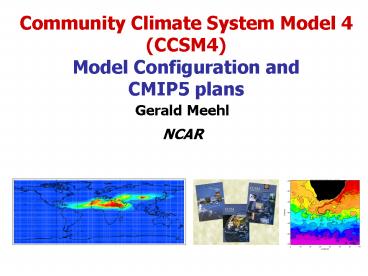Community Climate System Model 4 PowerPoint PPT Presentation
1 / 10
Title: Community Climate System Model 4
1
Community Climate System Model 4 (CCSM4) Model
Configuration and CMIP5 plans
Gerald Meehl NCAR
2
Two Tracks for the Community Atmospheric Model
(CAM)
Track 1
- Essentially CAM3.5
- Modifications to convection (better El Nino)
- Substantial code revisions
- Remaining parameterizations as in CAM3, but
- FV dynamical core becomes default
- Polar filters GW Froude number
- All aerosols can be interactive (for CAM3, only
Sulfur and Soot were calculated) - prescribed aerosol datasets
- Revised aerosol optics
- Coupled to other new surface components
- Defined as CAM4 within CCSM4
3
Two Tracks for CAM
Track 5
- CAM3.5
- New cloud microphysics
- Revised ice clouds
- PDF based warm cloud fraction
- New Radiative Transfer
- New PBL and Shallow convection
- New macrophysics
- New aerosol formulation
- Tweaks to GWD and Mountain form drag
- Volcanic Aerosols
- Radiatively active consistent convective clouds
- The bleeding edge model
- Explicit connections between boundary layer
processes, shallow clouds, and cloud fraction - Much more flexibility, power, accuracy in
radiative transfer calculation - two moment (mass number) treatments for
clouds and aerosols - Modal aerosols, internal mixtures
- Explicit connections between aerosols, clouds,
drop and crystal activation, allowing treatment
of Aerosol Indirect Effect (Total AIE
1.2-1.5W/m2) - Much more consistent treatment of condensed
species for radiation, microphysics,
sedimentation, scavenging, etc - Much more consistent treatment of condensation
cloud fraction evolution - Stronger connections between clouds, the PBL, and
the surface
4
Ocean Component
Changes relative to CCSM3
- POP2 base code, including many infrastructure
changes - Increased vertical resolution (60-levels) and
changes in bottom topography - Modified anisotropic horizontal viscosity scheme
- Near-surface eddy flux parameterization (CPT)
- Vertically-varying isopycnal and thickness
diffusivities (CPT) - Sub-Mesoscale parameterization (CPT)
- Overflow parameterization (CPT)
- Tidally driven mixing scheme
- Horizontally-varying internal wave breaking
- Zenith angle dependent diurnal cycle of solar
forcing - Flux limited advection scheme (Lax-Wendroff)
- Passive tracer infrastructure and ecosystem codes
are operational
5
Sea Ice Component
Changes relative to CCSM3
- Community Ice Code (CICE) 4.0 Base Code
- Delta-Eddington Radiative Transfer in sea ice and
snow - Melt Pond Parameterization
- Arbitrary Number of Tracers (for example age,
melt ponds, aerosols) - Aerosol cycling and deposition on sea ice / snow
6
Land Component
Changes relative to CCSM3
- Carbon/nitrogen cycle model
- Based on BIOME BGC prognostic phenology
- Transient land use/land cover change
- Address the biogeophysical and biogeophysical
impact of LULC change - Urban model
- Heat island direct impact of climate change on
human health, e.g. heat waves - Revised soil hydrology
- Improved soil moisture storage/annual cycle,
partitioning of ET into its components, soil
moisture variability - Revised snow model
- New snow cover fraction aerosol deposition onto
snow (new climate feedback) vertically resolved
heating new snow age parameterization snow
burial of short vegetation - Permafrost
- Insulating effect of organic soil, deep soil
column - Revised Dynamic Global Vegetation Model
- Integrated with carbon/nitrogen model added
shrub PFT
7
Ocean Ecosystem Component
- Improved sedimentary iron source and scavenging
parameterizations - Reduces mismatch with observations (Moore and
Braucher, 2008) - Improved phytoplankton dynamic Si/C and Fe/C
ratios - Improves surface silicate and dissolved iron
distributions - Modifications to phytoplankton loss terms
- Better bloom dynamics and seasonal nutrient
drawdown at high latitudes - Incorporation of atmospheric N, P, and Si (in
addition to Fe) - N has modest impacts, and deposition is changing
rapidly since preindustrial - P and Si from the atmosphere have very small
impact on C cycle - Diazotroph utilization of fixed N sources
(nitrate, ammonium) (Moore, submitted) - Diazotrophs can fix N2, but now also take up
fixed N when available - Modified O2/Denitrification effect on
remineralization lengths - Length scales grow longer at low O2
8
CCSM Contributions to CMIP5
- Long-term simulations
- Track 1 at 1 horizontal resolution
- Both with and without coupled carbon cycle
- All core experiments some Tier 1 and Tier 2
- Track 5
- Some core, but none with coupled carbon cycle
- Some Tier 1
- Likely smaller ensembles than Track 1
- WACCM (next slide)
- Decadal simulations
- Ocean initialization via data assimilation
- Majority with Track 1
- 1 and likely 1/2 horizontal resolution
- Some with Track 5
- Some with WACCM?
9
CCSM Contributions to CMIP5
- Time slice simulations
- Track 1 at 35 km horizontal resolution
10
WACCM and CMIP5
- Based on Track 1 1.9 x 2.5 CCSM4.0
configuration - Atmospheric component
- Fully-interactive chemistry with 57 species
- Includes heterogeneous chemistry necessary for
ozone hole development recovery - Extensively validated in SPARC/CCMVal 2
- CLM3 / POP2 / CICE4 as in Track 1
- Planned minimum of 3 runs from 1960 to 2050
- 45 years of retrospective 20th Century
- 45 years using the RCP 4.5 scenario

